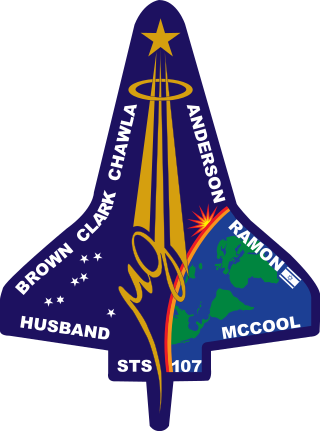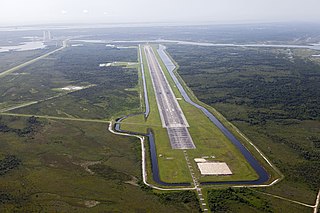
The Space Shuttle is a retired, partially reusable low Earth orbital spacecraft system operated from 1981 to 2011 by the U.S. National Aeronautics and Space Administration (NASA) as part of the Space Shuttle program. Its official program name was Space Transportation System (STS), taken from the 1969 plan led by U.S. Vice President Spiro Agnew for a system of reusable spacecraft where it was the only item funded for development.

Edwards Air Force Base (AFB) is a United States Air Force installation in California. Most of the base sits in Kern County, but its eastern end is in San Bernardino County and a southern arm is in Los Angeles County. The hub of the base is Edwards, California. Established in the 1930s as Muroc Field, the facility was renamed Muroc Army Airfield and then Muroc Air Force Base before its final renaming in 1950 for World War II USAAF veteran and test pilot Capt. Glen Edwards.

On Saturday, February 1, 2003, Space Shuttle Columbia disintegrated as it re-entered the atmosphere over Texas and Louisiana, killing all seven astronauts on board. It was the second Space Shuttle mission to end in disaster, after the loss of Challenger and crew in 1986.

STS-1 was the first orbital spaceflight of NASA's Space Shuttle program. The first orbiter, Columbia, launched on April 12, 1981, and returned on April 14, 1981, 54.5 hours later, having orbited the Earth 37 times. Columbia carried a crew of two—commander John W. Young and pilot Robert L. Crippen. It was the first American crewed space flight since the Apollo–Soyuz Test Project (ASTP) in 1975. STS-1 was also the maiden test flight of a new American spacecraft to carry a crew, though it was preceded by atmospheric testing (ALT) of the orbiter and ground testing of the Space Shuttle system.

STS-3 was NASA's third Space Shuttle mission, and was the third mission for the Space Shuttle Columbia. It launched on March 22, 1982, and landed eight days later on March 30, 1982. The mission, crewed by Jack R. Lousma and C. Gordon Fullerton, involved extensive orbital endurance testing of Columbia itself, as well as numerous scientific experiments. STS-3 was the first shuttle launch with an unpainted external tank, and the only mission to land at the White Sands Space Harbor near Alamogordo, New Mexico. The orbiter was forced to land at White Sands due to flooding at its originally planned landing site, Edwards Air Force Base.

STS-5 was the fifth NASA Space Shuttle mission and the fifth flight of the Space Shuttle Columbia. It launched on November 11, 1982, and landed five days later on November 16, 1982. STS-5 was the first Space Shuttle mission to deploy communications satellites into orbit, and the first officially "operational" Space Shuttle mission.

The NASA Neil A. Armstrong Flight Research Center (AFRC) is an aeronautical research center operated by NASA. Its primary campus is located inside Edwards Air Force Base in California and is considered NASA's premier site for aeronautical research. AFRC operates some of the most advanced aircraft in the world and is known for many aviation firsts, including supporting the first crewed airplane to exceed the speed of sound in level flight, highest speed by a crewed, powered aircraft, the first pure digital fly-by-wire aircraft, and many others. AFRC operates a second site next to Air Force Plant 42 in Palmdale, California, known as Building 703, once the former Rockwell International/North American Aviation production facility. There, AFRC houses and operates several of NASA's Science Mission Directorate aircraft including SOFIA, a DC-8 Flying Laboratory, a Gulfstream C-20A UAVSAR and ER-2 High Altitude Platform. As of 2023, Bradley Flick is the center's director.

The Columbia Accident Investigation Board (CAIB) was an internal commission convened by NASA to investigate the destruction of the Space Shuttle Columbia during STS-107 upon atmospheric re-entry on February 1, 2003. The panel determined that the accident was caused by foam insulation breaking off from the external fuel tank, forming debris which damaged the orbiter's wing, and that the problem of "debris shedding" was well known but considered "acceptable" by management. The panel also recommended changes that should be made to increase the safety of future shuttle flights. The CAIB released its final report on August 26, 2003.

STS-51-D was the 16th flight of NASA's Space Shuttle program, and the fourth flight of Space Shuttle Discovery. The launch of STS-51-D from Kennedy Space Center (KSC), Florida, on April 12, 1985, was delayed by 55 minutes, after a boat strayed into the restricted Solid Rocket Booster (SRB) recovery zone. STS-51-D was the third shuttle mission to be extended.

STS-37, the thirty-ninth NASA Space Shuttle mission and the eighth flight of the Space Shuttle Atlantis, was a six-day mission with the primary objective of launching the Compton Gamma Ray Observatory (CGRO), the second of the Great Observatories program which included the visible-spectrum Hubble Space Telescope (HST), the Chandra X-ray Observatory (CXO) and the infrared Spitzer Space Telescope. The mission also featured two spacewalks, the first since 1985.

STS-44 was a NASA Space Shuttle mission using Atlantis that launched on November 24, 1991. It was a U.S. Department of Defense (DoD) space mission.

Charles Gordon Fullerton was a United States Air Force colonel, a USAF and NASA astronaut, and a research pilot at NASA's Dryden Flight Research Facility, Edwards, California. His assignments included a variety of flight research and support activities piloting NASA's B-52 launch aircraft, the Boeing 747 Shuttle Carrier Aircraft (SCA), and other multi-engine and high performance aircraft.

Brewster Hopkinson Shaw Jr. is a retired NASA astronaut, U.S. Air Force colonel, and former executive at Boeing. Shaw was inducted into the U.S. Astronaut Hall of Fame on May 6, 2006.

John Elmer Blaha is a retired United States Air Force colonel and a former NASA astronaut. He is a veteran of five space missions aboard the Space Shuttle and Mir.

William John "Pete" Knight was an American aeronautical engineer, politician, Vietnam War combat pilot, test pilot, and astronaut. He was one of twelve pilots who flew the North American X-15, an experimental spaceplane jointly operated by the U.S. Air Force and NASA. He was also selected for participation in the X-20 Dyna-Soar program.

The Shuttle Landing Facility (SLF), also known as Launch and Landing Facility (LLF), is an airport located on Merritt Island in Brevard County, Florida, United States. It is a part of the Kennedy Space Center and was used by Space Shuttle for landing until July 2011. It was also used for takeoffs and landings for NASA training jets such as the Shuttle Carrier Aircraft and for civilian aircraft.

A runway safety area (RSA) or runway end safety area is defined as "the surface surrounding the runway prepared or suitable for reducing the risk of damage to airplanes in the event of an undershoot, overshoot, or excursion from the runway."

X-15 Flight 3-65-97, also known as X-15 Flight 191, was a sub-orbital spaceflight of the North American X-15 experimental spaceplane, carrying seven experiments to a peak altitude of 266,000 feet, above NASA's definition of the start of space at 50 miles (80 km) but below the Kármán line definition at 62 miles (100 km). The flight, on November 15, 1967, ended when the aircraft broke apart minutes after launch due to technical difficulties, killing the pilot Michael J. Adams and destroying the aircraft.





















